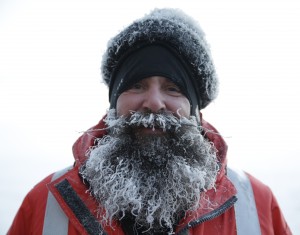by Christina Wertman, University of Rhode Island
With his remarkable beard, positive attitude and colorful shirts, Bern McKiernan is a pleasure to sail with on the R/V Sikuliaq.
Bern has been working as a marine technician on the R/V Sikuliaq since operations started in 2014. A marine technician is the liaison between the ship’s crew and the scientists. He is responsible for facilitating the science party’s needs based on the ship capabilities. Bern makes sure the scientists can access the Sikuliaq network, data and instruments while out at sea. His familiarity with the ship and the crew is extremely helpful for the scientists on board.

Bern McKiernan, a marine technician for the R/V Sikuliaq, is hard at work on an icy day. Photo courtesy of Bern McKiernan.
Before working on the Sikuliaq, Bern spent a total of 12 years working for Columbia University. The last 6 of those years he spent working as a marine technician on the R/V Marcus Langseth, a research vessel operated by Columbia. The similarity between equipment on the Marcus Langseth and the Sikuliaq, as well as the opportunity to work on a brand new ship, made the opening with Sikuliaq very appealing.
Unlike Bern’s previous ship, the Sikuliaq is ice capable, so the ship is best at conducting scientific research in cold weather regions. Bern explained that working in a cold weather environment can be challenging.
One of the largest differences between working in the open ocean and in areas with ice is the sea state. Unlike the open ocean, areas with ice are relatively calm due to the dampening effect of the ice cover. As the ship approaches iced covered areas, waves are not able to grow so the sea state becomes calmer. Bern describes sailing in ice-covered regions “like riding on a train”, which is smoother than the open ocean.
Despite the usually calmer sailing, working at higher latitudes presents unique obstacles related to the cold temperatures. For scientists and the crew, the cold brings higher personal risk and requires proper clothing when working outside. Likewise, the instruments also face a risk of getting too cold and even freezing when working in the ice. Sometimes sea ice can close over the deployed underwater instruments. Deploying instruments on the ice is even more hazardous and great safety precautions need to be taken.
In addition to working in Alaska, Bern has sailed to several exotic locations including Tahiti, Easter Island and Antarctica over the past 25 years (working for the Navy and on research vessels). While out at sea, he has seen a fair amount of sea life including Mola mola, killer whales, sharks, and flying fish. Although he has traveled to many places, he finds some of the most picturesque locations to be near his home port in Alaska. In particular, he described sailing by the Alaska coast as “just beautiful”.
Bern was hired before the ship was launched, and is a plank owner of the ship. This means he will get a physical piece of the ship once it is retired. This honor is only granted to the original crew of a ship.
